What is tobacco, its origin, cultivation and use
The history of tobacco is about 8000 years old. He was first domesticated in America, and in the 16th century. imported to Europe and Russia. Now there are tobacco plantations in more than 100 countries of the world, the plant is in constant demand on the market.
Over the centuries, tobacco has experienced a series of ups and downs. At one time, it was considered a panacea and was used as a cure for many diseases, at another - a ban was imposed on the plant, up to the death penalty.
From the article you will learn what tobacco is, what are its features, manufacture, and also all the most important about its smoking properties.
The content of the article
Origin and distribution
The spread of tobacco began in the 1st century. BC e. on the territory of America, but did not go beyond the continent until the arrival of the Europeans. The situation changed when in 1492 H. Columbus landed in America and the Indians brought him gifts, among which were dried tobacco leaves.
It is interesting!The sailor Rodrigo de Jerez, who traveled with Columbus, is considered the first smoker in Europe. The Spanish Inquisition considered that the man, from whose mouth and nose smoke comes out, possessed by the devil, and imprisoned de Jerez.
At the beginning of the 16th century, when the Spaniards created the first tobacco plantations, the plant began to spread throughout the world. Soon, successful promotion of smoking began in high society, although in some countries and cities (the Ottoman Empire, Bavaria, Zurich and Saxony) tobacco was banned, and smoking was punishable by up to the death penalty.
In Russia, tobacco first appeared under Ivan the Terrible. At first, smoking was popular among members of the Russian nobility, but Tsar Mikhail Fedorovich issued a decree banning tobacco. Only under Peter I was smoking legalized.
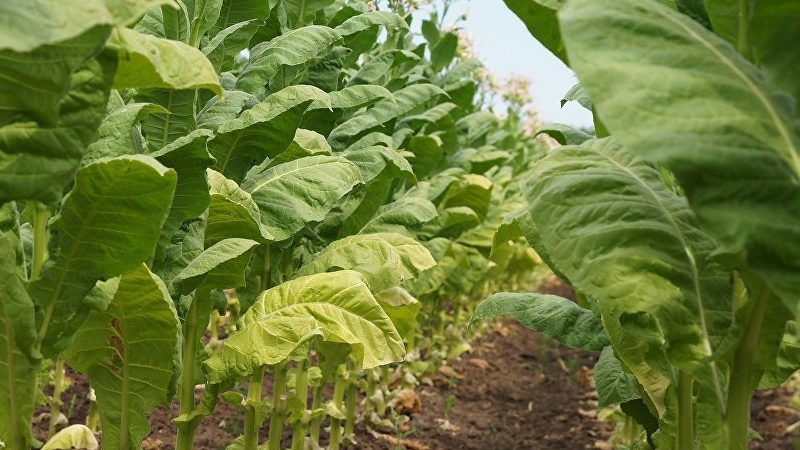
Biological description
Common tobacco belongs to the family Solanaceae (Solanaceae), the genus Tobacco (Nicotiana)... It is an annual (less often perennial) plant with a height of about 2 m. Around 6000 BC. e. culture took shape in the form in which we know it now.
The leaves are large, the flowers are pink, red or white and funnel-shaped. Their distinctive feature is their strong aroma. Corolla 5–6 cm long. The pistil has an upper ovary and a capitate stigma. The fruit is a box 1.5–2 cm in size, which contains a large number of small seeds.
Variety of varieties
There are 75 types of tobacco. Most valuable varieties for growing and processing (below are descriptions and photos):
- Broadleaf, or Maryland (lat.Nicotiana macrofilla). Features - red flowers, long tubular corolla and broad leaves. The side veins on them are located perpendicular to the main one.
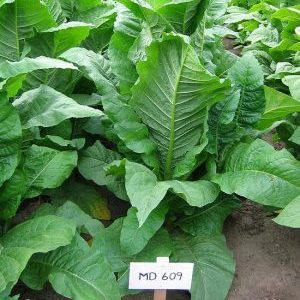
- Virginia (lat.Nicotiana tabacum). It is distinguished by pink flowers and a tubular corolla with sharp lobes. Leaves are oblong, sessile.
- Common shag (Nicotiana rustica). The flowers are yellowish with short tubes. Leaves are ovoid with a rounded tip.
- Girlish, or gummy (Nicotiana glutinosa). It has pink flowers with small tubes. Leaves are grayish green.
- Curly (Nicotiana crispa). Height - about 1.8 m, pink flowers, leaves have a characteristic bumpy surface.
Composition and properties
Tobacco leaves are a real chemical factory. Composition in many ways depends on the variety, a method of drying and fermentation, but on average a plant contains about 2500 different substances and compounds.
Despite the fact that tobacco is considered extremely harmful and hazardous to health, some substances in its composition are extremely valuable. For example, nicotinic acid is actively used in industry, in particular in medicine.
Chemical composition
The most active constituents of tobacco leaves include alkaloids:
- nicotine;
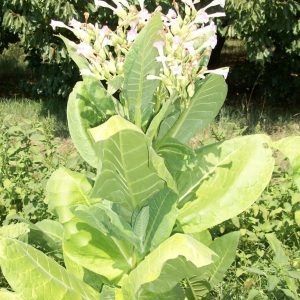
- nornicotine;
- cotinine;
- myosmin;
- anabazine;
- nicothirine;
- anatabine;
- 2,3-dipyridyl;
- amino acids;
- carbohydrates;
- sterols;
- phenolic compounds.
The processed leaves have a different composition. Depending on the variety, quantity and method of fermentation, the volume of substances in the leaves varies: nicotine - from 1 to 4%; carbohydrates - from 1 to 13%; essential oils - from 0.1 to 1.7%; organic acids - from 5 to 17%.
Benefits and harm to the body

Tobacco is valuable in medicine because it serves as a source of niacin. This substance has a number of functions in the body:
- participates in the metabolism, stimulating the process of energy production;
- regulates blood cholesterol levels;
- participates in the synthesis of hormones necessary for the body (serotonin, growth hormone);
- improves memory and sleep, the general condition of the nervous system;
- supports the work of the heart and blood vessels during ischemic disease and in the first stages of atherosclerosis;
- cleanses the body, which is why it is often used for intoxication;
- restores and improves digestion.
With its positive qualities, tobacco also brings considerable harm. The plant accumulates polonium-210, which passes from fertilizer into the leaves of the plant. This is one of the reasons for the development of bronchial cancer in smokers. It is impossible to remove the substance from the plant.
Attention! Substances such as resins, benzene and formaldehyde are extremely dangerous. They provoke the development of oncology, affect the lungs and respiratory tract, and negatively affect the digestive and circulatory systems.
Growing
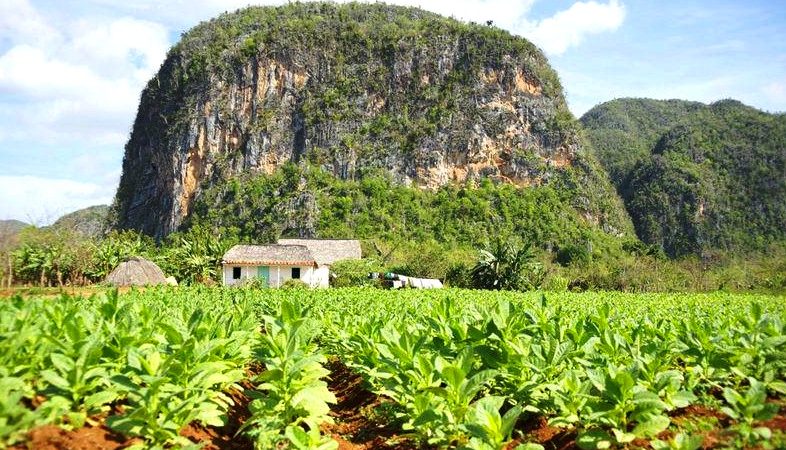
Most of the tobacco plantations are located in North America, India, China and Asia Minor. On the territory of the former Soviet Union, it is cultivated in the Transcaucasia, Crimea, Krasnodar Territory, Moldova, Uzbekistan and Kazakhstan.
At first, tobacco seedlings are grown in open ground or in special nurseries. When they grow up to 13-15 cm, they are transferred to plantations. After about 40 days, the leaves are harvested. On average, the entire process takes 15-17 weeks.
Procurement and storage
Collect raw materials from late summer to mid-autumn. Leaves are plucked from the tops of the bushes that receive maximum light. The lower layers are removed as they grow.
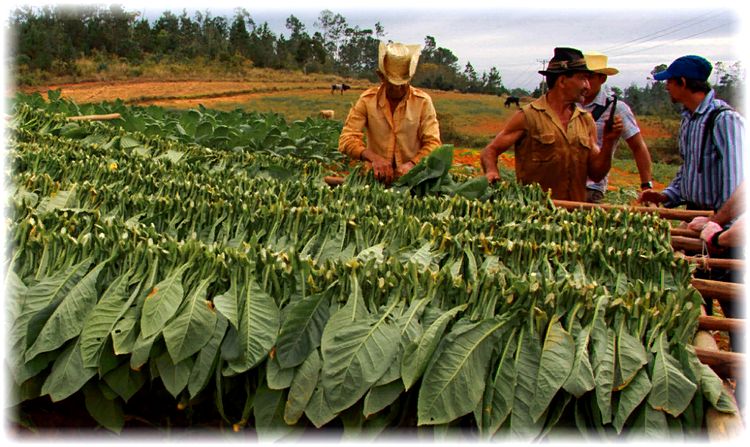
Drying

This process consists of two stages: languor and fixation.... In the first case, the tobacco leaves are kept at a temperature of about +25 ° C, when they are still alive. During fixation, moisture is directly removed from the leaves.
For drying, the tobacco is strung on a rope and placed in dryers. These are large rectangular sheds located near the plantations. There the leaves are tied in pairs and hung on poles-kuhes. As the plants dry up, these poles are placed closer to the ceiling, and fresh leaves are hung from below. Depending on the variety, the procedure takes from 25 days to 1.5 months. How it looks, look at the photo.
Fermentation
Fermentation is a chemical reaction in which organic matter is converted to inorganic.
Primary fermentation is carried out for all types of tobacco. To do this, the leaves are stacked (as they are called, "pylons") or sent to barrels, under a press. In this form, tobacco is stored in a dark, closed room for about a month.
After fermentation, the leaves are sorted, identified for quality and distributed to make cigars and regular cigarettes. The raw materials for the cigars are sent for aging, and the rest for the second fermentation. The whole process takes from 6 months to 3 years.
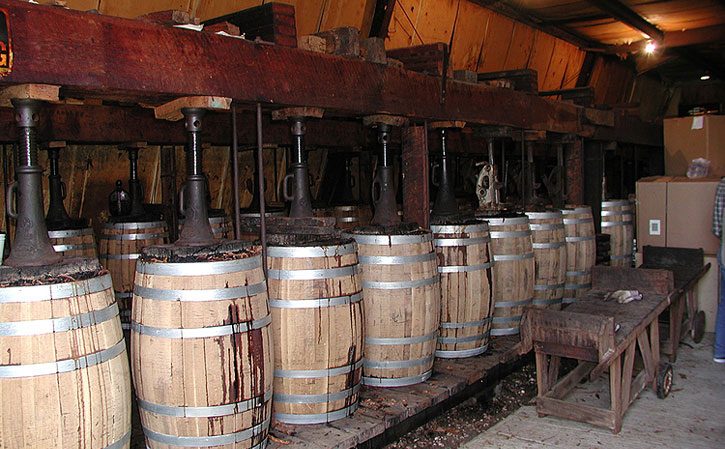
Application
The use of tobacco is very diverse. They find a place for him in medicine (traditional and folk), the chemical industry, gardening and even cooking. The plant was successfully adapted for some household needs.
For smoking
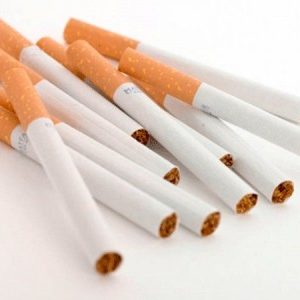
This is the primary role of tobacco in the world's most profitable industry. On sale tobacco products for every taste.
Cigarettes and pipes have become popular again among smokers. Therefore, many types of packaged tobacco of any kind are supplied to the market with a variety of aromatic and flavoring additives.They often radically change the taste of tobacco. A separate market niche is occupied by hookah tobacco.
At home
Some varieties of the culture perform a decorative function, for example, winged tobacco... It is often planted in gardens solely for beauty.
In agriculture, the plant improves the quality and fertility of the soil, so it is often planted in the fields before sowing wheat or rye. Tincture of tobacco helps control pests (aphids, red fleas or thrips).
The strong smell of the plant scares away moths, so some housewives use it to preserve woolen things.
It is interesting! Some chefs use tobacco as an ingredient in their dishes. At the XV International Cigar Festival in Havana, guests were offered such unusual dishes.
ethnoscience
Tobacco has been adapted to treat many diseases. Some even use it against tuberculosis and hemorrhoids.
The most popular recipes are as follows:
- Crushed leaves are used to treat colds.
- A decoction of tobacco is used against skin diseases.
- Raw materials insist on vodka and take for dizziness and nausea.
- Tobacco ointment serves as a pain reliever.
- Tincture of cigarettes is used to get rid of subcutaneous mites.
Read also:
The best recipes for pickled beets for the winter in jars.
What is Swiss chard, how to eat it correctly and how it can be useful.
Manufacture of tobacco products

The main use of raw materials is the manufacture of various tobacco products. Of these, cigarettes, cigars, cigarillos and hookahs hold the undoubted leadership.
The most common product is cigarettes. They are a paper stick, inside of which finely chopped tobacco leaves will interfere. Cigarettes are equipped with a filter that prevents harmful substances from entering the lungs.
It is interesting! Cigarettes in their usual form appeared only in 1913. It was then that the world-famous Camel brand was born.
Cigar Is a tobacco product made from tightly rolled leaves. Raw materials for cigars undergo at least two fermentation. Another feature is the lack of a filter.
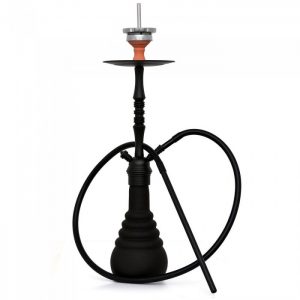
Cigarillos are very similar in shape to cigars, but in their manufacture they use shredded tobacco. Cigarillos also do not have a filter, and smoke from them should not be inhaled.
Hookah - an ancient smoking device. It consists of a flask where water is poured (it serves as a filter), a shaft extending from it (its function is to retain harmful substances), a hose and a bowl for tobacco.
Important! It is widely believed that hookah is a safe alternative to cigarettes. This is not the case: hookah tobacco contains the same harmful substances as regular tobacco. The water filter filters out only the smallest part of them.
The consequences of smoking
According to the World Health Organization, tobacco smoking is the leading cause of preventable death in the world... Smoking caused 100 million deaths in the 20th century.
Breathing toxic chemicals (such as carbon monoxide) together with fumes increases the risk of heart and lung disease. Carcinogens (benzopyrene and tar), which are found in large quantities in smoke, can cause cancer.
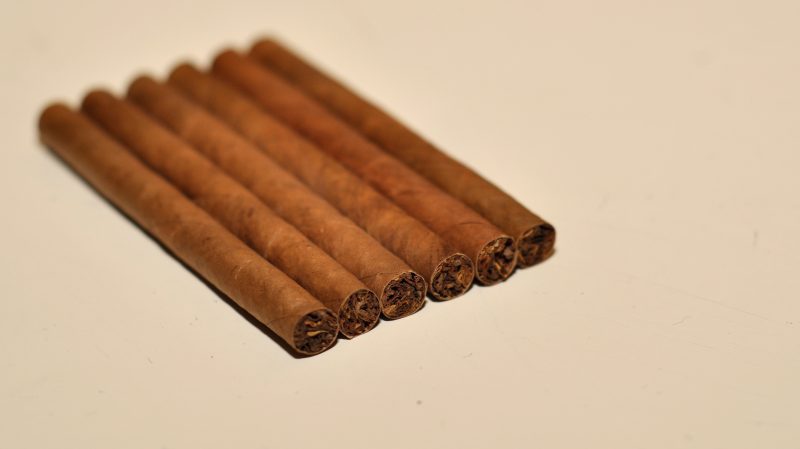
Smokers are at risk of developing:
- heart attack;
- stroke;
- chronic obstructive pulmonary disease;
- emphysema;
- cancer (especially the risk of getting cancer of the lungs, larynx, mouth and pancreas).
Passive smokers receive almost the same dose of hazardous substances. They also inhale the combustion products of tobacco, including carbon monoxide and nitrogen. Secondhand smoke causes about 600,000 deaths a year, almost a third of the deaths are children.
The use of tobacco leads to a violation of the blood supply to the skin, due to which it does not receive the necessary amount of oxygen. As a result, the skin becomes dull, takes on an unpleasant grayish tint, loses its elasticity and becomes dehydrated.
Cigarettes make your breath smell bad and your tooth enamel turns yellow.The general condition of the oral cavity deteriorates, the mucous membranes suffer greatly, the gums deteriorate and the acid-base balance is disturbed. Smokers are more likely to develop periodontal disease and lose teeth.
The nicotine contained in tobacco is addictive and subsequently addictive. Women and adolescents are most vulnerable to this. They develop addiction much faster than men.
Tobacco is extremely dangerous for pregnant women. Inhalation of smoke has a detrimental effect on the reproductive system. Smoking cries out for a number of fetal pathologies and congenital diseases.
Important! On April 16, 2008, Russia joined the convention on tobacco control. At that time, 145 countries and the European Union had already accepted it.
Conclusion
Tobacco has firmly entered the life of a modern person. The plant has found applications in various industries, from horticulture to medicine. The benefits and importance of culture in these areas are beyond question.
However, whatever the benefits of tobacco, we must not forget that smoking it brings great harm. At the same time, not only the smoker himself suffers, but also those who are next to him. Despite the beliefs of retailers and marketers, there is no safe way to smoke tobacco.